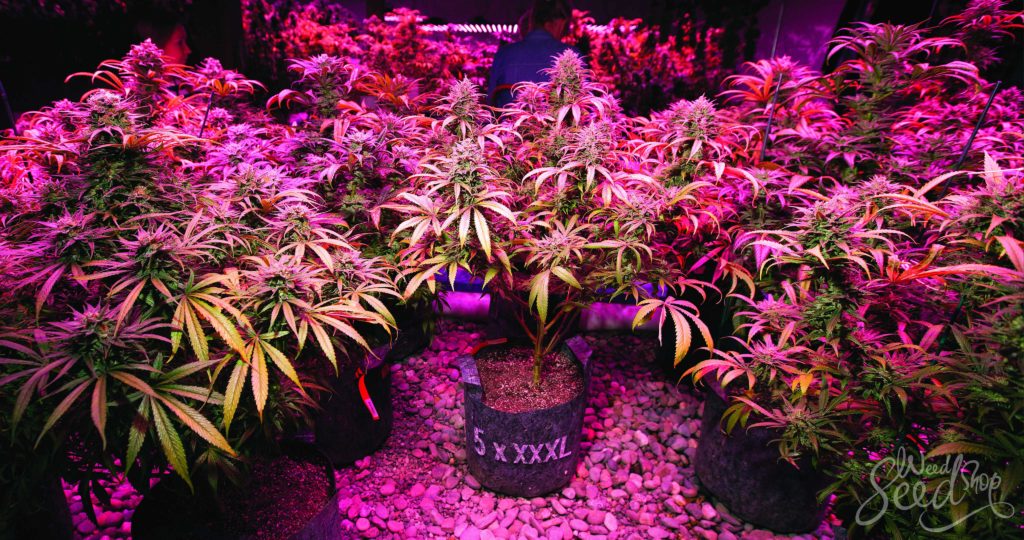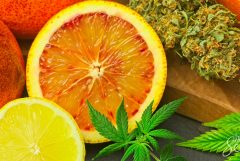The genetics of your plant, or the strain that you choose, will play a huge role in how much cannabis you are able to harvest. The yield on each strain will vary, but you can use this guide as a way to increase the yields of any strain that you are growing. Let’s get started!
The main focus of cannabis growers is how to get bigger plants with better yields, and there are many things you can do to encourage your cannabis plants to grow better. If you’re just starting out with growing weed, the focus should be on having a healthy, happy plant. You can worry about maximizing yields at another time. However, if you are a seasoned grower who is looking to harvest more bud, this article will cover a few different ways that you can ensure a bigger yield. The methods described are ways for you to manipulate the environment and the way your plants grow to work for you to increase yields when growing weed.
1. Increase the light intensity for bigger yields
Of course, if your weed is growing outside, the only way to increase light intensity is to be sensitive about where you plant it. All plants need a good source of light to grow, as light acts as food for your weed plants. So, this method applies mainly to those who are growing weed indoors.The darkness period for cannabis plants is just as vital to a successful yield as the light period, but increasing the light intensity at the correct time can assist in a bigger yield. The process that occurs during the light period is photosynthesis, during which the plant is able to produce sugars which help the buds grow. During the darkness period, the cannabis plant produces a hormone called florigen, which is the hormone which allows the plant to flower at all.
Firstly, it is important to appreciate that taller, thinner plants will not yield as much as shorter, bushier ones. This is one of the ways to identify if your plant is having a problem with light intensity. Ensuring that the intensity of light is high enough during the vegetation stage ensures that the plant will develop branches for buds that are not so spaced out, creating a bushier plant. The way to ensure bigger yields is to increase the light intensity during the flowering stage. It is important to ensure that, when the light intensity is increased, the actual temperature of the room stays the same, as during the flowering stage it is also important that the plant remains cool.
The easiest way to increase the intensity of light without increasing the temperature of the room is to move the light closer to the plant. Be careful not to move it too close so as not to burn the tips of the leaves. Ensure that each of the buds is exposed completely to a high-intensity light that is even all around the plant. Giving any weed plant more light is the best way to encourage buds to grow bigger and better. If you have reached the point in your grow room where light is at the highest intensity it could possibly be, you can also try adding CO2. CO2 assists weed plants in absorbing light, and so adding it at the right time can also increase your yield. However, if CO2 is added before the light intensity is at a point where it is almost too high, then it will not make any difference to the operation.
2. Use the correct amount of nutrients to maximize yields
The trick with using nutrients to assist the growth of your plant is ensuring that you do not use too little or too much. It is a common misconception that nutrients are food for your cannabis plant, but the truth is that light is food for your weed plant. The nutrients you give are simply to assist in the process of photosynthesis, encouraging the plant to digest the food that it has received, if you will.
Nutrient deficiency is detrimental to the health of your plant, and your plant will let you know that it is lacking in a certain nutrient first and foremost through the leaves. If the leaves are beginning to wilt or have changed colour from the rest of the leaves, this is an indication that your cannabis plant is lacking in a certain nutrient. It is actually safer to hover on the side of having too little nutrients for your plants, because this problem can be easily fixed. The main problem for growers is a lack of understanding that adding more nutrients to your plant is not always the best decision for it.
A lot of growers end up with the problem of giving their plants too many nutrients, and this results in a phenomenon called nutrient burn. The temptation for growers can be to mix a lot of nutrients together without understanding which nutrients they are giving their plant and why, and an overload of nutrients can lead to poor plant health. So, when you are purchasing a nutrient schedule, only use half of what is suggested for it on your plant. Observe its behaviour and, if it requires more nutrients, you can work on adding them.
About 2-4 weeks before harvesting your plant it is actually better to give your plants fewer nutrients. As your plant begins to focus its energy on producing healthy, big buds, it does not matter so much if some of the leaves on the top of the plant wither and fall off. Too many nutrients in this stage of the plant’s growth will actually hinder the bud production of the plant. You will subsequently lose out on your yield.
3. Increase the yield by pruning
Pruning your cannabis plants is a really simple way to increase your yields before harvest time. You can begin to consider pruning your plants when the different parts of it are receiving different amounts of light. For example, if the top of your plant is growing more rapidly than the bottom parts (because the top receives the most light usually), then you can consider pruning to ensure a more even distribution of light around the plant.
A popular technique of training or pruning the cannabis plant is called “topping,” and it is a process that can be undertaken during the vegetative state. It involves pruning off the branch tip of a main cola so that the focus of energy is no longer on it. The next two branches laterally will become the main branches and the energy will be focused onto them. If this process is repeated regularly, there will be almost twice as many branches, meaning more potential places for buds to grow.
There are methods of pruning which manipulate the way in which the plants grow entirely. For example, there is a method of pruning called low-stress training (LST). This effectively convinces your plant to grow flatter and wider, rather than taller and lankier. This ensures a better light distribution around the entire plant, which encourages better yields. Pruning and light distribution go hand in hand. You could find that the lower half of your plant is not receiving light as intensely as the top. You might consider pruning the leaves on the lower half of your plant so that the energy the light receives can be focused on the top, which is receiving the most light.
4. Control the temperature and humidity for optimum yields
Maintaining good control over the grow environment is extremely important in ensuring a better yield. You can optimize growing conditions by maintaining good control over the temperature and humidity of your growing room. Plants that have been exposed to temperatures that are too cold generally experience a slower growth rate than those that are maintained at a good temperature. They can survive, but they do not produce higher yields. Temperatures that are too high will also slow down a plant’s growth. The indication that the temperature is too high is when your plant is displaying leaves that have turned brownish and are beginning to wilt.
Ensuring the temperature is maintained and controlled well during the flowering stage is the most important. If it is too hot (above 26 degrees centigrade), bud growth will slow down. This will in turn negatively effect your yield. It will also reduce the potency and the smell of your buds.
Humidity also affects the yield of your plant. When humidity is too high you run the risk of dealing with plant problems like mould and white, powdery mildew. It is important to keep this under control. Again, the most important part is during the flowering stage. Keep humidity low to encourage the trichomes to appear and to ensure the potency.
5. Harvest at the right time
This is something all growers should be working hard to do. It not only affects the yield but also the quality of the buds. The flowering time is going to be different for every strain. Make sure you have a good idea of when you can expect flowering time to be for your plant. If you harvest your buds too early, you risk losing up to 25% of growth. Most bud growth occurs in the last two to three weeks of harvesting time. If you harvest too late, you risk losing some of the potency of your buds as the trichomes’ content begins to deteriorate.
Choosing the optimum harvesting time is one of the most important steps in growing cannabis. There is a period of time that is optimum for ensuring the strongest and the most buds from your plant. Harvesting too early or too late can seriously affect the quality and the yield.









